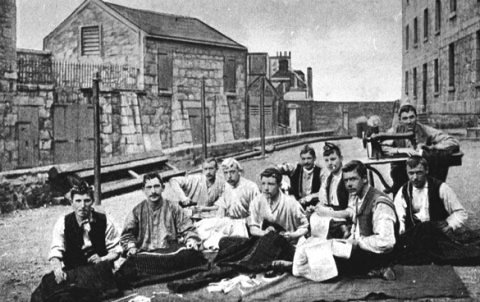OK, because you asked.
I am Regimental Kiltmaker to The Canadian Scottish Regt. here in Victoria. The current kilts I make for them are made from newly woven fabric in 16oz weight.
I also own a current RRS kilt. It is a hand finished, machine sewn kilt also made from 16oz weight fabric.
As a Docent at the Royal BC Museum I have access to many kilts made prior to and during WWI. While the fabric is generally coarser than that woven today the weight is not the mythical 22 oz stuff that everyone seems to think of. I have weighed these kilts and the fabric varies between 15oz and 19oz.
I have also noticed a marked difference between an officers and an enlisted kilt. In general officers had their kilts custom made. Usually by one of the Scottish based kilt shops but not by those holding the military contracts. I have seen and held two made of very heavy silk. Most of the other officer's kilts are made from far finer woven, lighter weight, Merino wool.
I also notice that there is no one, single standard way to make these older kilts. Some have the elastic loops in the back of the pleats used for parade occasions. Some are machine sewn except for the Fell area. One was hemmed from fabric that does not have a kilt selvedge. I have seen just about every type and method of closure imaginable. One had no fasteners and was obviously pinned as evidenced by the holes where straps and buckles would be today. One had a single long strap that went all the way from the under-apron edge - around the back - to a buckle on the outer apron edge. In almost every case where the two prong buckles were used the straps have been perforated so many times that they have failed like a sheet of paper toweling.
There is also a wide range of quality to the manufacture, the thread used, and the stitching. I have held two kilts with Scottish Contract labels in them where the stitching is of a very heavy, thick stuff almost like yarn. The stitches are huge and are plainly visible from across the room.
I am a believer that "The proper military issue kilt" is a myth. I've seen far too many examples and far too many differences in military kilts to be able to say what a 'proper' kilt would actually be.
There is a very famous photo of The Gordon Highlanders sitting around outside their barracks making their own kilts. There is plainly a sewing machine in the picture. It would seem that there was no single regimental kiltmaker available and that this unit did not get its kilt from a contracted kiltmaker.

If you are looking for a kilt from the period when kilts were worn in combat you will need to find one from WWI and kilts like this are usually in museums and private collections. I don't remember ever seeing an actual WWI era kilt on EBay going for less than antique prices.
But good luck and keep us posted.
Last edited by Steve Ashton; 17th June 16 at 03:15 PM.
Steve Ashton
www.freedomkilts.com
Skype (webcam enabled) thewizardofbc
I wear the kilt because: Swish + Swagger = Swoon.















Bookmarks